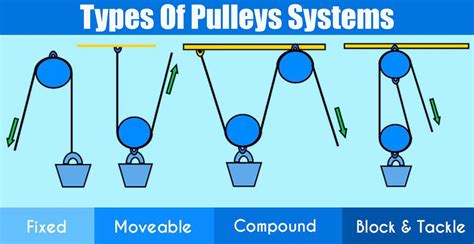The Ultimate Guide to Pulleys: Empowering Mechanical Engineering
Introduction
Pulleys, the unsung heroes of the mechanical world, play a pivotal role in transmitting motion and power. Their simple yet ingenious design has revolutionized industries, from construction to manufacturing, and has made our lives easier in countless ways. In this comprehensive guide, we will delve into the intricacies of pulleys, exploring their types, applications, advantages, and pitfalls. By the end, you will have a profound understanding of these indispensable mechanical elements and be equipped to harness their potential effectively.
Understanding the Basics of Pulleys
A pulley is a grooved wheel with a rope or cable running around its circumference. When a force is applied to one end of the rope, it causes the pulley to rotate, transmitting the force to the other end of the rope. This simple principle enables pulleys to:
-
Change the direction of a force: A pulley can redirect a force by 180 degrees, making it possible to pull objects upward with downward force.
-
Reduce the effort required to lift objects: By utilizing the leverage principle, pulleys can multiply the force applied, making it easier to lift heavy objects.
-
Increase the speed of movement: Pulleys can also be used to increase the speed of movement by allowing the rope to travel faster than the force being applied.
Types of Pulleys
Depending on their design and usage, pulleys can be classified into several types:

1. Fixed Pulleys:
- Fixed to a stationary support
- Change the direction of a force without altering its magnitude
2. Movable Pulleys:
- Attached to the object being lifted
- Reduce the effort required to lift the object
3. Compound Pulleys:
- Combinations of fixed and movable pulleys
- Amplify the force applied, making lifting even easier
4. Sheaves:
- Grooved wheels used in block and tackle systems
- Designed for heavy-duty lifting applications

Applications of Pulleys
Pulleys find applications in a wide range of industries and everyday situations, including:
-
Construction: Cranes, elevators, and pulleys are used to lift heavy materials and equipment during construction projects.
-
Manufacturing: Pulleys are used in conveyor systems, machinery, and assembly lines to move materials and products.
-
Power Transmission: Pulleys are used in belt and chain drives to transmit power between shafts and wheels.
-
Automotive: Pulleys are found in serpentine belts, alternators, and other components of vehicles.
-
Everyday Use: Pulleys are used in pulleys for lifting curtains, opening windows, and adjusting height-adjustable furniture.
The Physics Behind Pulleys
The operation of pulleys can be explained by a few fundamental principles of physics:
-
Law of Conservation of Energy: The total energy of a closed system remains constant.
-
Law of Leverage: The distance from the fulcrum to the point of force application determines the force required to move an object.
-
Principle of Pulleys: The tension in the rope wrapped around a pulley is the same on both sides.
Calculating Mechanical Advantage
The mechanical advantage of a pulley system is defined as the ratio of the output force to the input force. It determines how much easier it is to lift an object using a pulley compared to lifting it directly.
-
For fixed pulleys: Mechanical advantage = 1
-
For movable pulleys: Mechanical advantage = 2
-
For compound pulleys: Mechanical advantage = 2^n, where n is the number of movable pulleys
Common Mistakes to Avoid When Using Pulleys
To ensure the safe and effective use of pulleys, it is crucial to avoid certain common mistakes:
-
Overloading: Using a pulley to lift more weight than it is rated for can damage the pulley or the rope.
-
Improper Rope Selection: Using a rope that is too thin or weak can cause it to snap or break.
-
Incorrect Usage: Using a fixed pulley to lift an object directly (without a movable pulley) does not provide any mechanical advantage.
-
Neglecting Friction: Friction in the pulley system reduces mechanical advantage and can lead to inefficiencies.
-
Lack of Maintenance: Regular inspection and maintenance of pulleys and ropes is essential to prevent accidents and ensure optimal performance.
Step-by-Step Approach to Using Pulleys
To use pulleys effectively, follow these steps:
-
Select the Right Pulley: Choose an appropriate pulley type and size for your application.
-
Install and Secure the Pulley: Mount the pulley securely and ensure the rope or cable is properly routed.
-
Attach the Rope or Cable: Attach the rope or cable to the pulley and the object to be lifted.
-
Apply Force: Pull the rope or cable to apply force to the object and lift it.
-
Adjust and Maintain: Monitor the system and adjust the rope or cable as needed to ensure smooth operation and prevent wear and tear.
Pros and Cons of Using Pulleys
Pros:

- Increase force or change its direction
- Reduce effort required to lift or move objects
- Increase speed of movement
- Durable and cost-effective
Cons:
- Inefficiencies due to friction
- Limited lifting height
- Requires proper installation and maintenance
- Can be noisy if not properly lubricated
Call to Action
Now that you have a comprehensive understanding of pulleys, harness their power to make your projects, tasks, and everyday life easier. Utilize the knowledge and tips provided in this guide to select, install, and use pulleys correctly and safely. Whether you're lifting heavy objects, transmitting power, or simply opening a window, pulleys can empower you to achieve more with less effort.

